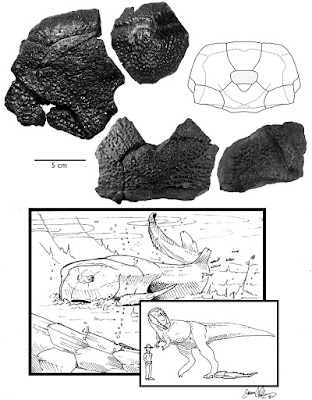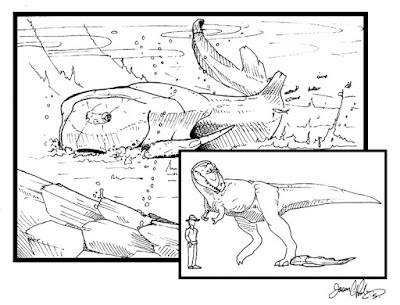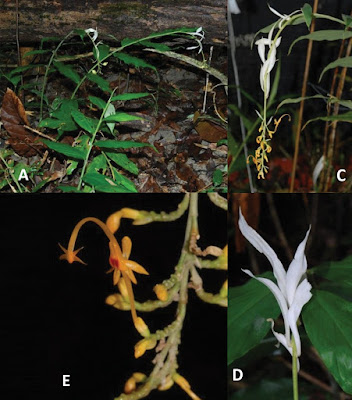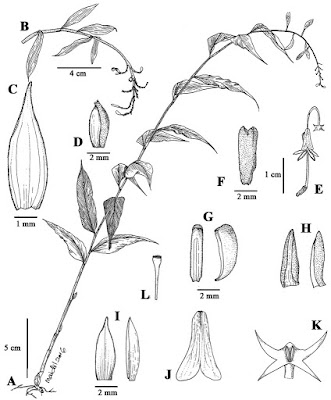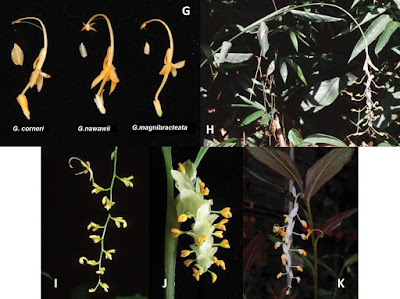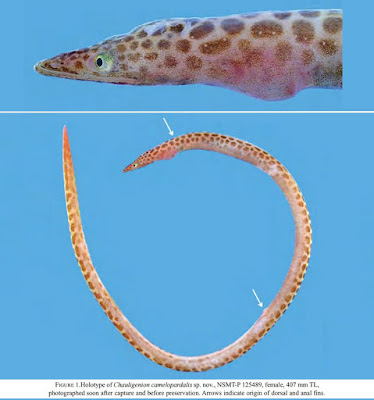[Most Recent Entries] [Calendar View]
Wednesday, October 26th, 2016
| Time | Event | ||||||||
| 12:12a | [PaleoIchthyology • 2016] Bothriolepis rex • A New Large-bodied Species of Bothriolepis (Antiarchi) from the Upper Devonian of Ellesmere Island, Nunavut, Canada
ABSTRACT New material from the Upper Devonian (Frasnian) Nordstrand Point Formation of Ellesmere Island, Nunavut, Canada, represents the largest known species of antiarch and the first described from the Nordstrand Point Formation. Bothriolepis rex, sp. nov., is additionally remarkable for the thickness and compactness of its dermal skeletal plates. The new species is diagnosed by a preorbital recess with a horizontal rostral margin; the presence of a wide unornamented border surrounding the infraorbital sensory line; central sensory lines that meet the margin of the nuchal close to the lateral corners; a supraotic thickening that does not extend caudal to a transverse crista of the nuchal; and a tall lateral lamina of the anterior dorsolateral. The thick and compact armor of Bothriolepis rex, sp. nov., recalls that of the co-occurring Perscheia pulla and gives occasion to a physical and ecological review of dermal skeletal mass and density in large-bodied, bottom-dwelling organisms in nonmarine ecosystems during the Late Devonian. SYSTEMATIC PALEONTOLOGY ANTIARCHI Cope, 1885 BOTHRIOLEPIDIDAE Cope, 1886 BOTHRIOLEPIS Eichwald, 1840 BOTHRIOLEPIS REX, sp. nov. Bothriolepis sp. Elliott et al., 2004. Holotype— NUFV 1192, nuchal plate (Fig. 3). Etymology— From the Latin ‘rex,’ king, in reference to the large body size. Type Locality and Horizon— NV2K11 site (N77 06.1630 W87 09.0640), Nordstrand Point Formation near Okse Bay on southern Ellesmere Island, Nunavut, Canada. Palynological data indicate a middle Frasnian age (Maclarenii zone of Embry and Klovan, 1976). Jason P. Downs, Edward B. Daeschler, Valentina E. Garcia and Neil H. Shubin. 2016. A New Large-bodied Species of Bothriolepis (Antiarchi) from the Upper Devonian of Ellesmere Island, Nunavut, Canada. Journal of Vertebrate Paleontology. DOI: 10.1080/02724634.2016.1221833 A New ‘King’ — New, Gigantic, Ancient Armored Fish Discovered https://shar.es/1E5ANd | ||||||||
| 9:28a | [Botany • 2016] Globba magnibracteata • A New Globba (Zingiberaceae) with Large White Floral Bracts from Peninsular Malaysia
Abstract Globba magnibracteata Y.Y.Sam, sp. nov. is described and illustrated. Colour plates, a preliminary conservation assessment and a discussion of its closely related taxa are provided. Keywords: Endemic, ginger, Globbeae, taxonomy, Terengganu, Zingiberaceae Diagnosis: Globba magnibracteata is similar to G. albobracteata N.E.Br. where both are placed in the subgenus Globba section Sempervirens. They have the same vegetative morphologies and inflorescence structure but differ in having wide spreading or strongly deflexed white sterile bracts versus the green appressed sterile bracts of G. albobracteata. The elliptic fertile bracts of G. magnibracteata are smaller (1.1–1.2 cm long) compared to the obovate bracts of G. albobracteata which are about 3 cm long. The cincinnus stalk of G. magnibracteata is also shorter (less than 1 cm) than that of G. albobracteata (2–4 cm). Globba magnibracteata has bulbils with many roots and one bamboo-like shoot distinct from the one-root-one-shoot bulbils in G. albobracteata. Etymology: The epithet is derived from Latin and refers to the large (magnus) floral bract (bractea). Distribution and ecology: Globba magnibracteata is only known from Jengai Forest Reserve, Peninsular Malaysia. The plants were found scattered on the shady and moist forest floor with a thick humus layer in the lowland dipterocarp forest, a tropical evergreen rainforest.
Yen Yen Sam and Halijah Ibrahim. 2016. A New Globba with Large White Floral Bracts from Peninsular Malaysia. PhytoKeys. 73: 117-124. DOI: 10.3897/phytokeys.73.9737 | ||||||||
| 2:58p | [Ichthyology • 2016] Chauligenion camelopardalis • A New Genus and Species of Deepwater Snake Eel (Anguilliformes: Ophichthidae) from the East China Sea
A new genus and species of ophichthid eel, Chauligenion camelopardalis McCosker and Okamoto, is described based on a specimen trawled at 150 m off western Okinawa. It differs from other ophichthids in its elongation, its pointed tail and snout, lower jaw extension, anterior nostril condition, elongate jaws, gill arch reduction, vertical gill openings, numerous small closely packed teeth, lack of pectoral fins, and its yellowish-tan coloration overlain with rows of brown spots. It is similar to genera of the tribe Ophichthini; however, we are unable to assign it with confidence. Keywords: Fish taxonomy, Ophichthidae, Chauligenion camelopardalis, genus and sp. nov, East China Sea.
DIAGNOSIS.— an elongate ophichthine with tail longer than head and trunk, body cylindrical, becoming laterally compressed in tail region; snout and tail tip pointed; lower jaw slightly extended; anterior nostril a hole above outer lip, without a tube; posterior nostrils along upper lip; jaws elongate, capable of closing completely; orbit large, in posterior half of upper jaw, its rear margin above rictus; gill openings low lateral, vertical; median fins elongate, not elevated; dorsal-fin origin above gill opening; pectoral fins absent; teeth small, conical, numerous and densely packed; preopercular pores 3; coloration yellowish-tan overlain with rows of brown spots. DISTRIBUTION.— Known only from the type specimen, collected by trawl in 150 m from the East China Sea. ETYMOLOGY.— From the Greek chaulios (prominent) and genion (chin), neuter, in reference to its obtrusive lower jaw tip. The epithet is derived from the latin camelopardalis (giraffe), in reference to its coloration, to be treated as a noun in apposition. New English name: Giraffe-spotted Snake Eel; New Japanese name: Kirin-umihebi John E. McCosker and Makoto Okamoto. 2016. Chauligenion camelopardalis, A New Genus and Species of Deepwater Snake Eel (Anguilliformes: Ophichthidae) from the East China Sea. PROCEEDINGS OF THE CALIFORNIA ACADEMY OF SCIENCES. Series 4, 63(9); 321–328. |
| << Previous Day |
2016/10/26 [Calendar] |
Next Day >> |
